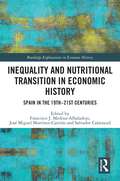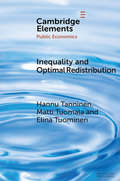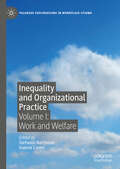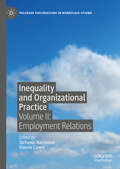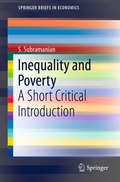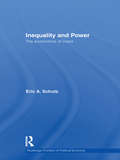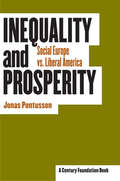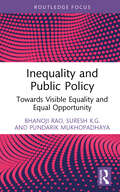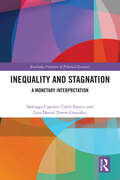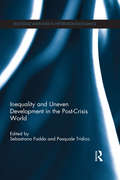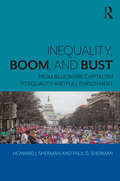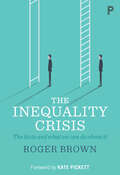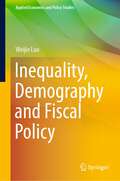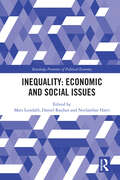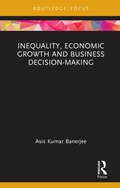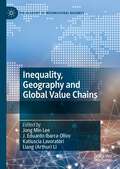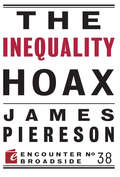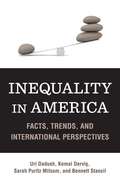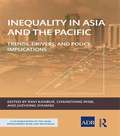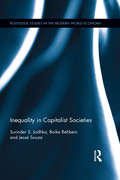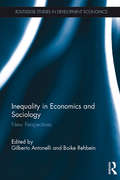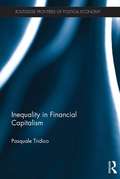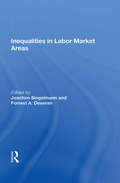- Table View
- List View
Inequality and Nutritional Transition in Economic History: Spain in the 19th-21st Centuries (Routledge Explorations in Economic History)
by Francisco J. Medina-AlbaladejoFood consumption and nutrition are historically among the most characteristic features of inequality in living standards driven by socioeconomic, gender, generational and geographical reasons. Nutrition directly impacts mortality, life expectancy, height and illness and thus becomes a good indicator of living standards and their evolution over time. However, one issue that remains unresolved is how to measure past diet inequalities with the available sources. This book evaluates nutritional inequalities in Spain from the nineteenth century to the present day. It explores the socioeconomic, gender, generational and geographical variations in food consumption and nutrition in Spain during this period. Deriving historical data on nutrition and diet has always been difficult due to issues with available sources. This book adopts a multi-dimensional approach and two complementary methodologies capable of presenting a more comprehensive picture: the first analyses diets based on primary sources, while the second examines the effect of nutritional inequalities on biological living standards, with special emphasis on average height. This combination allows for greater precision than previous studies on the impacts of food inequality. This book will be of significant interest to scholars from different academic branches, especially historians, economic historians and historians of science, economists, and also doctors, endocrinologists, paediatricians, anthropologists, nutritionists and expert in cooperation and development.
Inequality and Optimal Redistribution (Elements in Public Economics)
by Hannu Tanninen Matti Tuomala Elina TuominenFrom the 1980s onward income inequality increased in many advanced countries. It is very difficult to account for the rise in income inequality using the standard labour supply/demand explanation. Fiscal redistribution has become less effective in compensating increasing inequalities since the 1990s. Some of the basic features of redistribution can be explained through the optimal tax framework developed by J.A. Mirrlees in 1971. This Element surveys some of the earlier results in linear and nonlinear taxation and produces some new numerical results. Given the key role of capital income in the overall income inequality it also considers the optimal taxation of capital income. It examines empirically the relationship between the extent of redistribution and the components of the Mirrlees framework. The redistributive role of factors such as publicly provided private goods, public employment, endogenous wages in the overlapping generations model and income uncertainty are analysed.
Inequality and Organizational Practice: Volume I: Work and Welfare (Palgrave Explorations in Workplace Stigma)
by Valerie Caven Stefanos NachmiasBringing together international authors, this edited collection addresses the need for greater inclusivity within organizational policy and practice, in order to tackle both visible and invisible inequalities amongst employees. Evidence suggests that more positive employment relationships can be brought about by tackling diversity issues, yet there are still ‘grey areas’ existing in the current legislative framework. Volume I explores the way that these hidden inequalities can be used to identify an individual as ‘other,’ and how this ultimately affects their wellbeing and welfare at work. Analysing social justice and stigma, as well as nuanced issues within the workplace, this book is a thought-provoking read for scholars of HRM, practitioners and policy-makers.
Inequality and Organizational Practice: Volume II: Employment Relations (Palgrave Explorations in Workplace Stigma)
by Valerie Caven Stefanos NachmiasBringing together international authors, this edited collection addresses the need for greater inclusivity within organizational policy and practice, in order to tackle both visible and invisible inequalities amongst employees. Volume II reflects the shift in thinking around organizations’ responsibility to recognize and value diversity and equality, and examines the wider implications for employment relations and working conditions. Providing strategic insight into diversity management, the authors aim to advance our understanding of informal discrimination in the workplace, offering practical suggestions for better leadership and allocation of resources. A useful guide for practitioners, policy-makers and scholars of HRM and organization, this book presents solutions to inequality issues in the workplace, with the goal to building stronger employment relations.
Inequality and Poverty: A Short Critical Introduction (SpringerBriefs in Economics)
by S. SubramanianThis book provides an entry into the subjects of disparity and deprivation, by attending to issues that have a bearing on certain salient philosophical and conceptual aspects of these subjects. The student doing a graduate course in the measurement of inequality and poverty is all too often plunged directly into the complexities of Schur-convex functions, dominance conditions, partial orders and the axiomatics of characterization theorems. Inequality and poverty as phenomena with profound social and moral implications for the world we live in tend to get submerged in a treatment of the subject that is more suggestive of applied mathematics than of the material conditions of life. This is in no way to deny that measurement must deal uncompromisingly with measurement, and therefore with the protocols of formal logic and technical rigour. Having said this, it seems fair to suggest that one’s appreciation of the formalities – as well as of the limitations and ambiguities - of measurement is only aided by a relatively gentle introduction to the subject. This would call for a prior, or accompanying, engagement with the underlying concepts, the philosophical bases, the political salience, the normative values, and the critical facts of the subjects under investigation. It is this necessary background that is emphasized in this book, which is a collection of articles published earlier in the popular press, and intended for consumption by any curious general reader or student with a taste for critical enquiry. The contents of the book will be useful as much for the aspiring scholar as for the interested lay reader looking for a gateway into the subject.
Inequality and Power: The Economics of Class (Routledge Frontiers Of Political Economy Ser. #140)
by Eric A. SchutzThis book is about the causes and consequences of economic inequality in the advanced market economies of today. It is common that in market systems people choose their own individual economic destinies, but of course the choices people make are importantly determined by the alternatives available to them: unequal opportunity is the critical determinant of economic disparities. This begs the question; from where do the vast inequalities of opportunity arise? This book theorizes that power and social class are the real crux of economic inequality. Most of mainstream economics studiously eschews questions involving social power, preferring to focus instead on "individual choice subject to constraint" in contexts of "well-functioning markets". Yet both "extra-market" power structures and power structures arising from within the market system itself are unavoidably characteristic of real-world market-based economies. The normal working of labor and financial markets engenders an inherent wealth-favoring bias in the distribution of opportunities for occupational choice. But that bias is greatly compounded by the economic, social, political and cultural power structures that constitute the class system. For those power structures work to distribute economic benefit to class elites, and are in turn undergirded by the disparities of wealth they thus help engender. Inequality and Power offers an economic analysis of the power structures constituting that class system: employers’ power over employees; the power of certain businesses over others; professionals’ power over their clients and other employees; cultural power in the media and education systems; and political power in "democratic" government. Schutz argues that a "class analysis" of the trend of increasing economic inequality today is superior to the mainstream economic analysis of that trend. After considering what is wrong with power-based inequality in term of criteria of distributive justice and economic functionality, the book concludes with an outline of various possible correctives. This book should be of interest to students and researchers in economics, sociology, political science and philosophy, as well as anyone interested in the theories of social class.
Inequality and Prosperity: Social Europe vs. Liberal America (Cornell Studies in Political Economy)
by Jonas PontussonWhat are the relative merits of the American and European socioeconomic systems? Long-standing debates have heated up in recent years with the expansion of the European Union and increasingly sharp political and cultural differences between the United States and Europe. In Inequality and Prosperity, Jonas Pontusson provides a comparative overview of the two major models of labor markets and welfare systems in the advanced industrial world: the "liberal capitalist" system of the United States and Britain and the "social market" capitalism of northern Europe. These two models balance concerns of efficiency and equity in fundamentally different ways. In the 1990s the much-heralded forces of globalization (together with demographic changes and attendant political pressures) seemed to threaten the very existence of the social-market economies of Europe. Were the social compacts of Sweden and Germany outmoded? Would varieties of capitalism remain possible, or were labor-market and social-welfare arrangements converging on the U.S. norm? Pontusson opposes the notion of inevitable convergence: he believes that social-market economies can survive and indeed flourish in the contemporary world economy. He bases his argument on an enormous amount of highly specialized research on eighteen countries, using national-level data for the last thirty years. Among the areas he explores are labor-market dynamics, income distribution, employment performance, wage bargaining, firm-level performance, and the changing possibilities for the welfare state.
Inequality and Public Policy: Towards Visible Equality and Equal Opportunity (Routledge Studies in the Modern World Economy)
by Bhanoji Rao Suresh KG. Pundarik MukhopadhayaThis book’s concern is with visible inequalities in housing, health, and education, and policy initiatives to address them. The authors offer readers a summary of evidence on inequalities – not only in income, gender, and wealth but also in education, health, and housing. They showcase temporal and cross-country trends as well as the policy initiatives to minimize visible inequalities. The book also discusses policy initiatives and provides clarity on what works, what does not, and what may be of use when formulating public policies. Seventeen countries were chosen for focus based on their share in global population; of these, seven are given special focus, which together account for a little over half the world’s population. Offering current research as well as insights into prospects for visible inequalities, the book is an essential read for students and professionals interested in the study of visible inequalities and equal opportunity.
Inequality and Stagnation: A Monetary Interpretation (Routledge Frontiers of Political Economy)
by Carlo Panico Santiago Capraro Luis Torres-GonzálezThe book examines how the outgrowth of the financial industry has contributed to the recent tendencies towards inequality and stagnation. It proposes a monetary interpretation of these events using a Classical–Keynesian theoretical approach derived from the work of Keynes and Sraffa. The approach moves from the distributive conflicts among economic and social groups, presuming that they influence the legislation shaping the organisation of the markets and the policy of the authorities. It argues that the degrees of liquidity of assets, which reflect the individual perceptions of their future prices, ultimately depend on the organisation of the markets and policy decisions.The development of his work persuaded Keynes that it was necessary to revolutionise the scientific foundations of economic discipline to effectively interpret events and recommend policies. He consequently introduced in 1932 a monetary theory of production. Following these lines, Sraffa proposed in Production of Commodities to take the rate of interest as an independent variable in the theory of distribution.Using the Classical–Keynesian approach, the book shows how the changes in legislation and policies since the abandonment of the Bretton Woods agreements have caused the outgrowth of finance and how these alterations have raised financial instability. It identifies various competitive mechanisms through which financial events can affect income distribution and growth, describing how they have triggered the recent tendencies towards inequality and stagnation.This book is essential reading for researchers studying the interactions among financial markets, distribution, and growth.
Inequality and the "American Model"
by Rafael Di Tella Ingrid VogelOfficial data that suggest economic inequality has been mounting in the United States on various dimensions since 1979. Many causes of such inequality have been postulated: technological change, globalization, demographic factors, and changes in public policy (notably changes in taxation during the Reagan presidency). Whether rising inequality is even a cause for concern is an open question. Some dimensions of inequality may be of concern, whereas other dimensions may be viewed as less problematic. To the extent that rising inequality is seen as a social problem that needs to be addressed, various policy proposals have been advocated.
Inequality and Uneven Development in the Post-Crisis World (Routledge Advances in Heterodox Economics)
by Sebastiano Fadda and Pasquale TridicoIn the years following the financial crash, two issues have become central to the debate in economics: inequality and the uneven nature of sustainable development. These two issues are at the core of this book which aims to explain three key questions: why inequality has increased so much in the last three decades; why most advanced economies are stagnating or are experiencing moderate economic growth; and why, even where economic growth is occurring, the quality of that growth is questioned. Inequality and Uneven Development in the Post-Crisis World is divided into three parts. The first part concerns the theoretical aspects of inequality, and ethical issues regarding economics and equality. The second part explores empirical evidence and policy suggestions drawing on the uneven levels of development and unprecedented levels of inequality experienced among advanced economies in the context of global financial capitalism. The third part focuses on sustainable development issues such as full employment, social costs of global trade liberalization, environmental sustainability and ecological issues. Along with inequality these issues are central for capitalism and for economic development. This volume is of interest to those who study political economy, sustainable development and social inequality.
Inequality, Boom, and Bust: From Billionaire Capitalism to Equality and Full Employment
by Howard J. Sherman Paul D. ShermanThere is enormous inequality between the income and wealth of the richest 1 percent and all other Americans. While the top 1 percent own 42 percent of all wealth in America, the lower half on the income ladder has only 2 percent of all of the wealth. This book develops a viewpoint contrary to the prevailing conservative paradigm, setting out both reasons for this inequality and the impact of this. To explain inequality, conservative economists focus on individual characteristics such as intelligence and hard work. This book puts forward new evidence to show that changes in economic inequality are primarily due to characteristics inherent in the standard operation of capitalist institutions. Furthermore, the authors seek to explain the cycle of boom and bust by considering political and social factors often overlooked by conservative economists. This book also explores how wealth influences political policies in a way that increases economic inequality even more than its present level. Through analysis of American political and economic institutions, Inequality, Boom, and Bust presents concrete steps for an activist, progressive policy to greatly reduce inequality through free healthcare, free higher education, and reduced unemployment.
The Inequality Crisis: The facts and what we can do about it
by Roger BrownWhat are the causes of the rise in economic inequality in the West and what can be done about it? Inequality has at last taken centre stage in the political discourse, but there is very little to explain the inequality debates and to offer solutions for the UK. Written by an award-winning academic and policymaker, this introductory book provides a comprehensive survey of all the available evidence, looking at both sides of the inequality argument. Fully up-to-date with the latest developments from the 2017 election and Brexit in the UK to Donald Trump’s election in the USA, this accessible and jargon-free introduction is international in scope and packed with fascinating facts and quotes. Roger Brown concludes by discussing whether current UK government policies will actually help reduce inequality and offers practical suggestions for what can be done, such as raising taxes on higher earners, tougher action against tax avoiders, helping people on lower incomes to save, and reducing inequalities in education.
Inequality, Demography and Fiscal Policy (Applied Economics and Policy Studies)
by Weijie LuoThis book aims to empirically and theoretically study how income inequality and demographic change affected fiscal policy and subsequent economic growth globally in the past decades from four perspectives. First, it briefly reviews the dynamic changes of income sources that contribute to inequality. Second, it distinguishes between income inequality induced by differences in labor productivity and income inequality induced by differences in capital income. Third, it briefly reviews the dynamic changes of tax composition in the age of demographic change. Last, it discusses the impacts of changes in age structure on the extent of taxes on income relative to expenditure. This book offers a comprehensive discussion to understand and analyze the reason, performance and challenge of fiscal policy and economic growth from the perspective of inequality and demographics.In addition to students, teachers and researchers in the areas of equity, demography, political economy and economic policy, this book is also of great interest to policy makers, planners and non-government agencies who are concerned with understanding and addressing poverty-related and aging-related issues in developed and developing countries.
Inequality: Economic and Social Issues (Routledge Frontiers of Political Economy)
by Mats Lundahl Neelambar Hatti Daniel RauhutInequalities of opportunity affect a person’s life expectancy and access to basic services and human rights through discrimination, abuse, and lack of access to justice. High levels of inequality of opportunity discourage skill accumulation, choke economic and social mobility, and, consequently, depress economic growth. Inequality also entrenches uncertainty, vulnerability, and insecurity; undermines trust in institutions and government, increases social discord and tensions, and triggers violence and conflicts. This book presents wide-ranging perspectives on economic inequality, as measured by differences in incomes and wealth. The contributors to the book explore how the economy is shaped in such a way as to generate differences in economic and social welfare between individuals, regions, and nations. But the book is not limited to economic perspectives: inequality is a many-faceted phenomenon that manifests itself in a number of ways.Thus, the book begins with a section which highlights some of the ‘standard’ features of inequality: class, gender, and age. The second section explores the manifestation of inequality in terms of differences in income and wealth. The third section looks at some of the causes of inequality, exploring the effects of discrimination and plunder (by those in power). The final section serves to drive home the point that geographic and institutional factors have an important place as well when it comes to shedding light on what equality is, how it manifests itself, and what its consequences are.This book will be essential reading for anyone interested in the causes and consequences of economic inequality including those in economics, sociology, politics, and geography.
Inequality, Economic Growth and Business Decision-Making (Routledge Focus on Management and Society)
by Asis Kumar BanerjeeIt is now widely recognised that rising inequality of income and wealth on the one hand and a slowdown in the rate of economic growth on the other are two of the most important challenges faced today by the global economy as well as by most of the developing economies. This book starts by explaining how these two issues are interrelated. There is no dearth of books on the role that the economic policies of the government can play in meeting these twin challenges. The role of business managers in the private sector of the economy, however, is a relatively neglected area. This book seeks to close this gap in the literature. The central message of the book is that, contrary to popular belief, it is in the interests of private business itself that business managers take into account the effects that their decisions have on the economy as a whole. It is shown that a failure to do so would hurt their own economic prospects in both the short run and the long. Emphasis is given on the importance of an appropriate orientation of managerial decisions and on the role of investors (i.e. the suppliers of capital) in inducing managers to take socially optimal decisions. The book is addressed as much to business managers and students in management courses as to the general reader. Therefore, no prior knowledge of advanced economic theory is presumed. All arguments are built from first principles.
Inequality, Geography and Global Value Chains (The Academy of International Business)
by Jong Min Lee J. Eduardo Ibarra-Olivo Katiuscia Lavoratori Liang Arthur LiThis contributed volume provides theoretical and empirical insights into a variety of contemporary issues about inequality, geography, and global value chains in today’s world, where global disruptions are prevalent, globalization is being transformed, and multinational enterprises (MNEs) are under pressure to promote sustainability. Many challenges and tensions created by growing inequality within and between countries, cities, and individuals, coupled with recent disruptions in the global economy, beg important questions regarding the role of MNEs. A valuable resource for scholars and students in international business, the book provides a richer understanding of how MNE activities are being affected by the complex dynamics of the modern global business environment and discusses what strategies they need to implement in order to adapt to a changing world, while accounting for the interests of a broader range of stakeholders.
The Inequality Hoax
by James PieresonThe controversy over inequality has gathered steam with the publication of Thomas Piketty's new book, Capital in the Twenty-First Century, a dense work of economic history that documents the rise of income inequality in recent decades and sets forth an agenda of taxation to deal with it. Piketty's treatise has turned into a rallying point for those favoring income redistribution and higher taxes on the rich. In this Broadside, James Piereson explains how Piketty's book is flawed and advances a narrow understanding of the market system. While misjudging the era in which we are living and misunderstanding the sources of inequality, Piketty's book proposes solutions that will make matters worse for everyone - the wealthy, the middle class, and the poor alike.
Inequality in America
by Uri Dadush Bennett Stancil Kemal Dervis Sarah P. MilsomA bedrock American principle is the idea that all individuals should have the opportunity to succeed on the basis of their own effort, skill, and ingenuity.-Federal Reserve Chairman Ben BernankeIncome inequality has been on the rise since the late 1970s, but the economic and financial crisis of 2008 instigated an unemployment epidemic that dramatically compounded this problem in the United States and catapulted the issue to the center of debate. There is wide agreement across the political spectrum that high inequality is contributing to undesirable circumstances such as stagnant household income, rising poverty rates, and increased borrowing and debt, though there is much less agreement on remedies. Inequality in America provides a snapshot of the issues posed by the growing concentrations of income, focusing on the United States but drawing on international comparisons to help set the context. The authors examine the economic, technological, and political drivers of inequality and identify worrying trends associated with its rise. They demonstrate how specific factors have exacerbated income inequality, including technological change, international trade, changes in labor market participation, and the increasing role of the financial sector. Their clear and concise exposition makes the issues surrounding income distribution accessible to a wider public.As they write in the conclusion: "We have argued that tackling the worst effects of inequality and re-establishing a measure of equal opportunity requires increased investment in crucial public goods: first, education; second, a more progressive and simplified tax system; and third, increased international cooperation to avoid a race to the bottom. Education, tax, and other such policies are pursued by other highperforming advanced countries and can be shaped for the United States in a way that is fully consistent with an efficient and competitive American economy."
Inequality in America
by Sarah P. Milsom Kemal Dervis Uri Dadush Bennett StancilA bedrock American principle is the idea that all individuals should have the opportunity to succeed on the basis of their own effort, skill, and ingenuity.--Federal Reserve Chairman Ben BernankeIncome inequality has been on the rise since the late 1970s, but the economic and financial crisis of 2008 instigated an unemployment epidemic that dramatically compounded this problem in the United States and catapulted the issue to the center of debate. There is wide agreement across the political spectrum that high inequality is contributing to undesirable circumstances such as stagnant household income, rising poverty rates, and increased borrowing and debt, though there is much less agreement on remedies. Inequality in America provides a snapshot of the issues posed by the growing concentrations of income, focusing on the United States but drawing on international comparisons to help set the context. The authors examine the economic, technological, and political drivers of inequality and identify worrying trends associated with its rise. They demonstrate how specific factors have exacerbated income inequality, including technological change, international trade, changes in labor market participation, and the increasing role of the financial sector. Their clear and concise exposition makes the issues surrounding income distribution accessible to a wider public.As they write in the conclusion: "We have argued that tackling the worst effects of inequality and re-establishing a measure of equal opportunity requires increased investment in crucial public goods: first, education; second, a more progressive and simplified tax system; and third, increased international cooperation to avoid a race to the bottom. Education, tax, and other such policies are pursued by other highperforming advanced countries and can be shaped for the United States in a way that is fully consistent with an efficient and competitive American economy."
Inequality in Asia and the Pacific: Trends, drivers, and policy implications
by Ravi Kanbur Changyong Rhee Juzhong ZhuangAsia’s rapid economic growth has led to a significant reduction in extreme poverty, but accompanied by rising inequality. This book deals with three questions: What have been the trends of inequality in Asia and the Pacific? What are the key drivers of rising inequality in the region? How should Asian countries respond to the rising inequality? Technological change, globalization, and market-oriented reform have been the key drivers of Asia’s remarkable growth and poverty reduction, but they have also had significant distribution consequences. These three drivers of growth cannot be hindered because they are the sources of productivity improvement and betterment of quality of life. This book will be useful to those interested in policy options that could be deployed by Asian countries in confronting rising inequality.
Inequality in Capitalist Societies (Routledge Studies in the Modern World Economy)
by Surinder S. Jodhka Boike Rehbein Jessé SouzaInequality is one of the most discussed topics of our times. Yet, we still do not know how to tackle the issue effectively. The book argues that this is due to the lack of understanding the structures responsible for the persistence of social inequality. It enquires into the mechanisms that produce and reproduce invisible dividing lines in society. Based on original case studies of Brazil, Germany, India and Laos comprising thousands of interviews, the authors argue that invisible classes emerge in capitalist societies, both reproducing and transforming precapitalist hierarchies. At the same time, locally particular forms of inequality persist. Social inequality in the contemporary world has to be understood as a specific combination of precapitalist inequalities, capitalist transformation and a particular class structure, which seems to emerge in all capitalist societies. The book links the configurations to an interpretation of global domination as well as to symbolic classification.
Inequality in Economics and Sociology: New Perspectives (Routledge Studies in Development Economics)
by Gilberto Antonelli Boike RehbeinInequality remains one of the most intensely discussed topics on a global level. As well as figuring prominently in economics, it is possibly the most central topic of sociology. Despite this, there has been no book until now that unites approaches from economics and sociology. Organized thematically, this volume brings international scholars together to offer students and researchers a cutting-edge overview of the core topics of inequality research. Chapters cover: the theoretical traditions in economics and sociology; the global and national structures of inequality in the contemporary world; the main dimensions of inequality (including gender, race, caste, migration, education and poverty); and research methodology. In presenting this overview, Inequality in Economics and Sociology seeks to build a bridge between the disciplines and the approaches. This book offers an encompassing understanding of an increasingly fragmented and highly specialized field of research. It will be invaluable for students and researchers seeking a single repository on the current state of knowledge, current debates and relevant literature in this key area.
Inequality in Financial Capitalism (Routledge Frontiers of Political Economy)
by Pasquale TridicoRecently, the issue of inequality has regained attention in the economic and political debate. This is due to both an increase in income inequality, in particular among rich countries, and an increasing interest in this issue by researchers and politicians. In the last three decades, income inequality among rich countries increased. This period also witnessed the growth of "financial capitalism", characterised by the strong dependency of economies on the financial sector, by the globalisation and intensification of international trade and capital mobility, and by the "flexibilisation" of labour markets and the reduction of wage shares. From the 1980s to the present day, this book considers the theoretical aspects of inequality (its foundations, definitions, approaches and origins) and examines empirical evidence of income inequality in a wide range of advanced economies. The key arguments in this volume are that income inequality increased during this period because labour and welfare became seen as costs to be compressed in "financial capitalism" rather than as a fundamental part of aggregate demand to be expanded. However, the welfare state is not a drain on economic performance and competitiveness, nor is it a barrier to economic efficiency. Instead, it is demonstrated that in countries that adopt "welfare capitalism", welfare state expenditure not only contributes to a reduction in inequality but also fosters economic growth. Inequality in Financial Capitalism is of great importance to those who study economics, political economy, labour economics and globalisation.
Inequality In Labor Market Areas
by Joachim SingelmannDuring the past two decades, many attempts have been made to refocus stratification research and the study of inequality. The contributors to this volume have a long-term concern with the importance of space and locality. Many of them belonged to a research project during the early 1980s that had as one of its main aims the analysis of labor force
